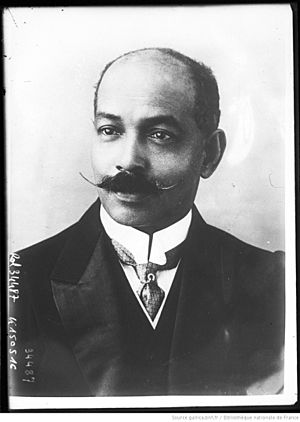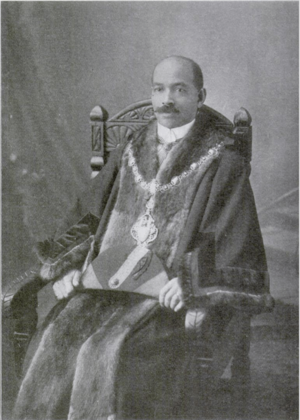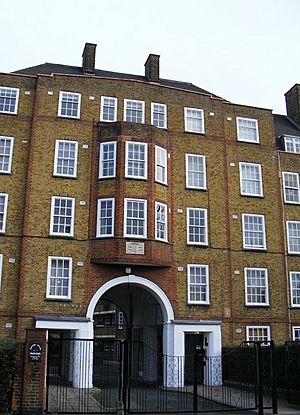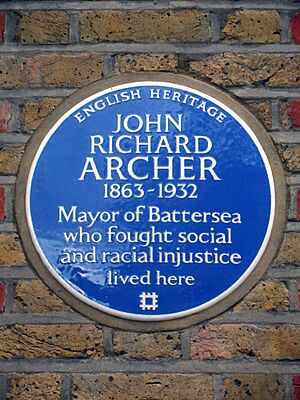John Archer (British politician) facts for kids
Quick facts for kids
John Archer
|
|
|---|---|
 |
|
| Born | 8 June 1863 Liverpool, Lancashire, United Kingdom
|
| Died | 14 July 1932 (aged 69) Battersea, London, United Kingdom
|
| Nationality | British |
| Occupation | Photographer, politician |
| Known for | Mayor of Battersea, Pan-Africanism |
John Richard Archer (born June 8, 1863 – died July 14, 1932) was an important British politician. In 1913, he made history by becoming the first black mayor of a town in London. This was the borough of Battersea. He was also a strong supporter of Pan-Africanism, a movement that brings together people of African descent worldwide. Archer was also the first president of the African Progress Union.
Contents
Early Life and Work
Archer was born in Liverpool, England. His father was from Barbados and his mother was from Ireland. For many years, he worked as a seaman, traveling around the world. He lived for some time in the United States and Canada.
In the 1890s, Archer returned to England with his wife, Bertha. She was a black Canadian. They settled in Battersea when he was in his thirties. He started studying medicine, but he earned money by running a small photography studio.
Getting Involved in Politics
Archer soon became active in local politics. He supported the Liberal politician John Burns. Archer was also friends with other radical thinkers in London.
In 1906, he was elected to the Battersea Borough Council. He was a member of the Progressive Party, which was linked to the Liberal Party. At the same time, another West Indian man, Henry Sylvester Williams, won a seat in Marylebone.
Archer worked hard to improve things for council workers. He successfully pushed for a minimum wage of 32 shillings a week. He lost his council seat in 1909 but was re-elected in 1912.
Becoming Mayor
In 1913, Archer was chosen to be a candidate for mayor of Battersea. At that time, the mayor was the political leader of the council. This was different from the ceremonial role mayors often have today.
During the election campaign, there were some negative and racist comments. Some people claimed he was not a British citizen. But Archer won the vote among his fellow councillors by 40 votes to 39.
After his victory, he gave a famous speech:
- "My election tonight means a new era. You have made history tonight. For the first time in the history of the English nation a man of colour has been elected as mayor of an English borough.
- "That will go forth to the coloured nations of the world and they will look to Battersea and say Battersea has done many things in the past, but the greatest thing it has done has been to show that it has no racial prejudice and that it recognises a man for the work he has done."
News of his success reached the United States. It was reported in January 1914 in The Crisis journal. This journal was published by the National Association for the Advancement of Colored People (NAACP).
Later Political Work
Over the years, Archer's political views became more left-leaning. In 1919, he was re-elected to the council as a representative for the Labour Party.
In 1918, he became the first president of the African Progress Union. This group worked to promote "advanced African ideas in liberal education." In 1919, he was a British delegate to the Pan-African Congress in Paris. Two years later, he led the Pan-African Congress in London.
In 1922, Archer left his council seat to work as an election agent for the Labour Party. He helped Shapurji Saklatvala, a Communist Party activist, run for parliament in North Battersea. Archer convinced the Labour Party to support Saklatvala. Saklatvala won, becoming one of the first Indian Members of Parliament in Britain.
Archer and Saklatvala continued to work together. They won again in the 1924 election. However, the Communist and Labour parties later separated. In the 1929 election, Archer worked for the official Labour candidate, who defeated Saklatvala.
Archer also held other important roles. He was a governor of Battersea Polytechnic. He was president of the Nine Elms Swimming Club. He also served on the Wandsworth Board of Guardians.
Final Years
Archer was elected to the council again in 1931 for the Nine Elms ward. When he died in 1932, he was the deputy leader of Battersea Council. He passed away on July 14, 1932, shortly after his 69th birthday. His funeral was held at the Church of Our Lady of Carmel in Battersea Park Road. He was buried in the council cemetery at Morden.
Interestingly, it was once thought that John Archer was the first black mayor in Britain. However, the American Negro Year Book 1914 reported that Allan Glaisyer Minns, a black man from the West Indies, was elected mayor of Thetford, Norfolk, in 1904.
His Legacy
John Archer's impact is still remembered today.
- Archer House, a building in the Battersea Village estate, was named after him in the 1930s.
- Wandsworth School was renamed in his honor in 1986, but it closed in 1991.
- There is a John Archer Way in Wandsworth and a John Archer Hall in Liverpool.
- In 2004, John Archer was included in the "100 Great Black Britons" list. He came 72nd in a public vote.
- In 2010, he received a blue plaque from the Nubian Jak Community Trust. Blue plaques are special signs that mark historic buildings.
- In April 2013, Royal Mail chose Archer as one of six people for their "Great Britons" commemorative postage stamp issue.
- In November 2013, English Heritage honored him with another blue plaque. This one is at his former home, 55 Brynmaer Road, Battersea.
- In March 2018, High View Primary school in Battersea was renamed Ark John Archer Academy.




